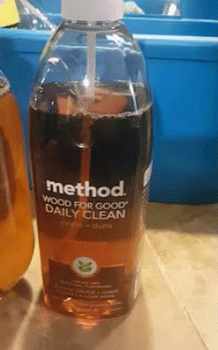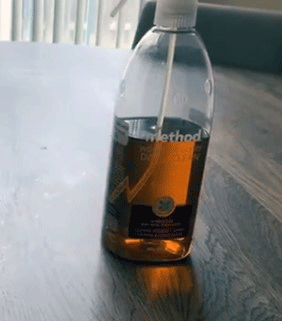I’m not one to geek out over cleaning products, but Method Wood for Good Daily Cleaner has me hooked. Its almond-scented, eco-friendly magic turned my dusty, smudged furniture into a shiny masterpiece. If you want your wood surfaces to glow without the toxic fumes, you’ve got to grab this stuff. In this review, I’m sharing my real-deal experience, breaking down the pros, cons, and hacks to make it work like a charm. Plus, I’ll pit it against other brands to show why it’s a winner. Trust me, your wood deserves this love.
My Method Wood Cleaner Journey: From Skeptic To Superfan

Let’s set the scene: my living room was a dust magnet, with my cherry coffee table and oak bookshelves looking like they’d survived a sandstorm. I’d been using a big-name aerosol polish that left a greasy film and a headache-inducing smell. Fed up, I decided to try Method Wood for Good Daily Cleaner after hearing it was non-toxic and eco-friendly. Spoiler alert—it’s now a staple in my cleaning caddy, but it took some trial and error to get here.
I grabbed the 28-ounce almond-scented spray bottle from a local store, drawn by its sleek, recyclable design and promise of plant-based ingredients. First use? I was nervous. My furniture’s old, and I didn’t want to ruin it. I sprayed a light mist on my coffee table, wiped with a microfiber cloth, and—bam!—the dust vanished, leaving a smooth, streak-free shine. The almond scent was like fresh-baked cookies, not a chemical assault. But I’ll be honest: I over-sprayed at first, and it felt a tad sticky until I dialed it back. A year later, my wood looks better than ever, though I’ve learned some tricks to avoid pitfalls. Let’s dive into what makes this cleaner a star and where it stumbles.
Pros Of Method Wood Cleaner: Why I’m Obsessed
Here’s why Method Wood for Good has me singing its praises:
Also Read: My Thought on Abracadabra Wonder Cleaner Reviews
- Streak-free shine: My coffee table gleams like it’s brand-new, with no hazy streaks or smudges.
- Heavenly almond scent: The nutty aroma is subtle and cozy, like a bakery, not a lab. No headaches here.
- Non-toxic formula: Plant-based and free of parabens, bleach, or ammonia—it’s safe for my kids and pets.
- Eco-friendly vibes: Made with recycled plastic and biodegradable ingredients, it’s a win for the planet.
- Easy to use: Spray, wipe, done. No rinsing or elbow grease needed, even on dusty surfaces.
- No greasy residue: Unlike waxy polishes, it leaves wood smooth, not slick or sticky.
- Versatile cleaning: Works on tables, cabinets, shelves—even sealed wood floors in a pinch.
- Affordable price: At $5-7 for 28 ounces, it’s budget-friendly compared to premium brands.
- Cruelty-free: Leaping Bunny certified, so no animals were harmed. My conscience loves that.
- Dust resistance: Surfaces stay cleaner longer, cutting down on my dusting marathons.
The shine is what hooked me—my furniture looks polished without that fake, plastic-y gloss. The scent makes cleaning feel like a treat, and knowing it’s safe for my toddler to touch the table afterward is huge. It’s versatile enough for my kitchen cabinets and bookshelves, and the price doesn’t make me flinch. Plus, I feel good about the eco-cred and cruelty-free label. It’s a cleaner that checks all my boxes.
Cons Of Method Wood Cleaner: The Not-So-Perfect Side
No product’s flawless, and Method has some quirks that bugged me:

- Weak on heavy grime: It struggles with sticky fingerprints or grease. I had to pre-clean tough spots.
- Scent’s not for everyone: Some folks find the almond smell too nutty or strong. My sister gagged.
- Over-spraying stickiness: Too much spray leaves a tacky film. Less is more, trust me.
- Dust resettling: It doesn’t repel dust as well as some polishes. I’m dusting weekly still.
- Plastic trigger issues: My bottle’s nozzle clogged after a few months. A rinse fixed it, but annoying.
- Not a polish: It cleans and conditions but won’t hide scratches or restore dull wood.
- Fragrance concerns: Linalool in the formula can irritate sensitive skin. Gloves help if you’re prone.
- Small bottle size: 28 ounces runs out fast if you’re cleaning a big house. Stock up.
- No deep conditioning: It’s great for daily use but doesn’t nourish wood like oil-based cleaners.
- Spotty availability: Sometimes out of stock locally. I’ve had to hunt it down online.
The grime issue was a bummer—my kid’s syrupy fingerprints needed extra scrubbing. The scent’s divisive; my sister swapped to a fragrance-free cleaner. Over-spraying was my rookie mistake, and the dust thing means I’m not cleaning less often. The trigger clogging had me cursing, and I wish it offered more restoration for my worn table. Still, these are minor gripes for a daily cleaner that delivers.
Method Vs. Other Brands: The Wood Cleaner Throwdown
I’ve tried a few cleaners and researched others to see how Method stacks up against Pledge, Murphy Oil Soap, and Howard Feed-N-Wax.
- Method vs. Pledge Multi-Surface Cleaner:
- Safety: Method’s non-toxic vs. Pledge’s chemical-heavy formula. I feel better with Method.
- Scent: Method’s almond beats Pledge’s harsh lemon-chemical vibe.
- Residue: Method’s residue-free; Pledge leaves a waxy film that attracts dust.
- Eco-cred: Method’s biodegradable; Pledge’s not eco-focused.
- Price: Both around $5-7, but Method’s plant-based feels like a steal.
- Cleaning: Pledge tackles grease better; Method’s gentler on delicate wood.
- Application: Method’s spray is even; Pledge’s aerosol can overspray.
- Shine: Method’s natural glow vs. Pledge’s shinier but artificial finish.
- Safety: Method’s pet- and kid-safe; Pledge needs ventilation.
- Versatility: Both work on multiple surfaces, but Method’s sealed-floor friendly.
- Method vs. Murphy Oil Soap:
- Formula: Method’s plant-based vs. Murphy’s oil-based. Murphy conditions deeper.
- Cleaning: Murphy cuts grease better; Method’s best for light dust and smudges.
- Scent: Method’s almond vs. Murphy’s strong, soapy smell. Method wins for me.
- Dilution: Murphy needs diluting; Method’s ready-to-spray simplicity rules.
- Residue: Method’s cleaner wipe; Murphy can leave a slight film if overused.
- Price: Murphy’s cheaper ($4) but less eco-friendly than Method ($6).
- Eco: Method’s greener; Murphy’s packaging and formula lag behind.
- Safety: Both are pet-safe, but Method’s non-toxic edge feels safer.
- Shine: Method’s subtle sheen vs. Murphy’s richer glow on old wood.
- Ease: Method’s spray-and-wipe vs. Murphy’s bucket-and-rag hassle.
- Method vs. Howard Feed-N-Wax:
- Purpose: Method’s a cleaner; Howard’s a polish for restoring wood.
- Conditioning: Howard nourishes deeply; Method’s just for surface cleaning.
- Scent: Method’s almond vs. Howard’s citrusy wax smell. I prefer Method.
- Application: Method’s quick spray vs. Howard’s labor-intensive rub-in.
- Residue: Method’s residue-free; Howard leaves a protective wax layer.
- Price: Howard’s $8-10 vs. Method’s $5-7. Method’s easier on the wallet.
- Eco: Method’s biodegradable; Howard’s less eco-focused with wax.
- Shine: Howard’s luster lasts longer; Method’s shine is daily-fresh.
- Safety: Method’s non-toxic vs. Howard’s need for gloves and ventilation.
- Use: Method’s daily; Howard’s for monthly deep treatments.
Method’s my go-to for daily cleaning. Pledge is tougher on grime but feels harsh and waxy. Murphy’s great for conditioning but messier and less green. Howard’s a polish, not a cleaner, so it’s apples and oranges—use it for restoration, not dusting. Method wins for eco-conscious folks like me who want safe, easy, and effective.
Maintenance And Tips: Getting The Most Out Of Method Wood Cleaner
To make Method Wood for Good shine (pun intended), here’s how to use it like a pro:

- Use microfiber cloths: They grab dust and spread the cleaner evenly. I avoid cotton rags—they streak.
- Spray lightly: One or two spritzes per section. Overdoing it makes surfaces sticky, trust me.
- Wipe immediately: Don’t let it sit too long, or it’ll feel tacky. Quick spray, quick wipe.
- Pre-clean heavy grime: For sticky spots, use a damp cloth first. Method’s not a degreaser.
- Test on antiques: Spot-test on old or delicate wood. My vintage table was fine, but check yours.
- Clean the nozzle: Rinse the sprayer monthly to prevent clogs. Mine’s been clog-free since.
- Pair with polish: For extra luster, use Method Wood for Good Polish monthly. It hides scratches.
- Dust first: Use a dry cloth to remove loose dust before spraying. Cuts down on smearing.
- Ventilate if sensitive: The scent’s mild, but open a window if fragrances bug you.
- Store properly: Keep it in a cool, dry spot. My bottle leaked when stored upside-down.
Also Read: My Thought on Abracadabra Wonder Cleaner Reviews
I’ve got this down to a science now. Microfiber cloths are my secret weapon—they make the shine pop. Light sprays keep things smooth, and pre-cleaning tough spots saves frustration. I dust first to avoid muddy smears, and pairing with Method’s polish every few months keeps my furniture looking showroom-ready. Testing on my antique dresser saved me from potential disaster, and rinsing the nozzle is a quick fix. These habits make Method a breeze to use.
Frequently Asked Questions (Faq)
The shine lasts a few days to a week, depending on dust and use. My table stays glossy for about five days with light traffic. Regular use keeps it looking fresh.
Not at all—just spray and wipe with a microfiber cloth. I messed up by over-spraying at first, but once you go light, it’s foolproof. No mixing or rinsing needed.
It’s safe for sealed or finished wood like tables and cabinets. I tested it on my sealed oak floor, and it worked great. Unsealed wood? Spot-test first.
Conclusion: Method Wood Cleaner’s A Must-Have For Your Home
After a year with Method Wood for Good Daily Cleaner, I’m all in. It’s transformed my dusty, dull furniture into glossy showpieces with zero toxic vibes. The almond scent, eco-friendly formula, and easy application make cleaning a joy, not a chore. Sure, it’s not perfect for heavy grime, but for daily shine, it’s unbeatable. Grab this cleaner if you want your wood to sparkle safely and sustainably. You’ll love the results, and your furniture will thank you every time you spray.
